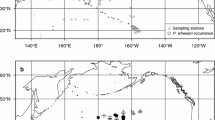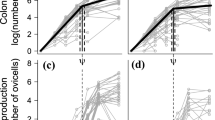Abstract
Based on the re-interpretation of published data, the von Bertalanffy growth function parameters of the coelacanth, Latimeria chalumnae, are estimated as L∞=218 cm total length, s.e. 23; K=0.059 (year−1), s.e. 0.012; t0=−3.3 (year), s.e. 0.5, corresponding to a life span of 48 years. The length–weight relationship of the form W=a*TL∧b, with wet weight (W) in g and total length (TL) in cm, is estimated as a=0.0278, b=2.89, r2=0.893, n=87, range=42.5–183 cm TL. Using extreme value theory, the maximum length for female coelacanths is estimated as 199 cm TL (95% confidence interval=175–223 cm TL) and for males as 168 cm TL (95% confidence interval 155–180 cm TL). Based on data from seven females with embryos or mature eggs, the length-at-first-maturity for females is estimated to be about 150 cm TL, corresponding to an age of about 16 years. Based on the value of t0=−3.3 years and on the presence of three scale rings found in a newborn coelacanth, the period of embryogenesis lasts for about three years, the longest known in vertebrates. The natural mortality rate is estimated at M=0.12. Population food consumption is found to be 1.4 times the existing biomass per year, and gross food conversion efficiency indicates that only 10% of the consumed food is utilized for somatic growth.
Similar content being viewed by others
References cited
Balon, E.K., M.N. Bruton & H. Fricke. 1988. A fiftieth anniversary reflection on the living coelacanth, Latimeria chalumnae: some new interpretations of its natural history and conservation status. Env. Biol. Fish. 23: 241–280.
Beverton, R.J.H. 1992. Patterns of reproductive strategy parameters in some marine teleost fishes. J. Fish Biol. 41 (Suppl. B): 137–160.
Binohlan, C. 1998. The maturity table. pp. 176–179. In: R. Froese & D. Pauly (ed.) FishBase 98: Concepts, Design and Data Sources, ICLARM, Manila.
Bruton, M.N. 1992. Addition to coelacanth inventory. Env. Biol. Fish. 33: 415.
Bruton, M.N. 1993a. Additions and corrections to the inventory of Latimeria chalumnae: II. Env. Biol. Fish. 36: 398–405.
Bruton, M.N. 1993b. Alterations and addition to coelacanth inventory: III. Env. Biol. Fish. 38: 400–401.
Bruton, M.N. 1999. Alterations and addition to coelacanth inventory: IV. Env. Biol. Fish. 54: 458–461.
Bruton, M.N. & M.J. Armstrong. 1991. The demography of the coelacanth Latimeria chalumnae. Env. Biol. Fish. 32: 301–311.
Bruton, M.N. & S.E. Coutouvidis. 1991. An inventory of all known specimens of the coelacanth Latimeria chalumnae, with comments on trends in the catches. Env. Biol. Fish. 32: 371–390.
Bruton, M.N. & R.E. Stobbs. 1991. The ecology and conservation of the coelacanth Latimeria chalumnae. Env. Biol. Fish. 32: 313–339.
Christensen, V. & D. Pauly. 1992a. The ECOPATH II-a software for balancing steady-state ecosystem models and calculating network characteristics. Ecol. Modelling 61: 169–185.
Christensen, V. & D. Pauly. 1992b. A guide to the ECOPATH II software system (version 2.1). ICLARM Software 6. International Center for Living Aquatic Resources Management, Manila. 72 pp.
Compagno, L.J.V. 1984. Sharks of the world. An annotated and illustrated catalogue of shark species known to date. FAO Fish. Synop. 125, part I: 1–249, part II: 251–655.
Erdmann, M.V., R.L. Caldwell & M.K. Moosa. 1998. Indonesian 'king of the sea' discovered. Nature 395: 335.
Forey, P. 1998. History of the coelacanth fishes. Chapman & Hall, London. 440 pp.
Formacion, S.P., J.M. Rongo & V.C. Sambilay. 1991. Extreme value theory applied to the statistical distribution of the largest lengths of fish. Asian Fish. Sci. 4: 123–135.
Fricke, H., O. Reinicke, H. Hofer & W. Nachtigall. 1987. Locomotion of the coelacanth Latimeria chalumnae in its natural environment. Nature 329: 331–333.
Fritzsch, B. & P. Moller. 1995. A history of electroreception. pp. 39–55. In: P. Moller (ed.) Electric Fishes: History and Behavior, Fish and Fisheries Series 117, Chapman & Hall, London.
Froese, R. & C. Binohlan. 2000. Empirical relationships to estimate asymptotic length, length at first maturity, and length at maximum yield per recruit in fishes. J. Fish Biol. (in press).
Froese, R. & D. Pauly (ed.) 1998. FishBase 98: concepts, design and data sources.With 2 CD-ROMs. ICLARM, Manila. 293 pp.
Froese, R. & D. Pauly (ed.) 1999. FishBase 99: concepts, structure, et sources des données (translators N. Bailly & M.L.D. Palomares). ICLARM, Manila. 324 pp. with 3 CD-ROMs.
Gayanilo, F.C. Jr. & D. Pauly (ed.) 1997. FAO-ICLARM stock assessment tools (FiSAT). Reference manual, FAO Computerized Information Series (Fisheries) No. 8, FAO, Rome. 262 pp.
Gayanilo, F.C. Jr., P. Sparre & D. Pauly. 1996. FAOICLARM stock assessment tools (FiSAT) user's manual. FAO Computerized Information Series (Fisheries) 8, FAO, Rome. 126 pp.
Gumbel, E.J. 1954. Statistical theory of extreme values and some practical applications, a series of lectures. National Bureau of Standards, Applied Mathematics Series, 33. US Government Printing Office, Washington. 51 pp.
Hughes, G.M. 1972. Distribution of oxygen tension in the blood and water along the secondary lamella of icefish gills. J. Exp. Biol. 56: 481–492.
Hughes, G.M. 1976. On the respiration of Latimeria chalumnae. Zool. J. Linn. Soc. 59: 195–208.
Hughes, G.M. & Y. Itazawa. 1972. The effect of temperature on the respiratory function of coelacanth blood. Experientia 28: 1247.
Hureau, J.-C. & C. Ozouf. 1977. Détermination de l'âge et croissance du coelacanthe Latimeria chalumnae Smith, 1939 (Poisson. Crossoptérygien, Coelacanthidé). Cybium 2: 129–137.
IUCN. 1996. 1996 IUCN red list of threatened animals. IUCN, Gland. 378 pp.
Locket, N.A. 1980. Some advances in coelacanth biology. Proc. R. Soc. Lond. B 208: 265–307.
McAllister, D.E. & C.L. Smith. 1978. Mensurations morphologiques, dénombrements méristiques et taxonomie du Coelacanthe, Latimeria chalumnae. Naturaliste Can. 105(2): 63–76.
McCosker, J.E. 1979. Inferred natural history of the living coelacanth. pp. 17–23. In: J.E. McCosker & M.D. Lagios (ed.) The Biology and Physiology of the Living Coelacanth, Occ. Pap. Calif. Acad. Sci. No. 134, San Francisco.
Nammack, M.F., J.A. Musick & J.A. Colvocoresses. 1985. Life history of spiny dogfish off the Northeastern United States. Trans. Amer. Fish. Soc. 114: 367–376.
Northcutt, R.G. 1980. Anatomical evidence of electroreception in the coelacanth (Latimeria chalumnae). Zentralbl. Vet. Med., Reihe C, 9: 289–295.
O'Gorman, R., D.H. Barwick & C.A. Bowen. 1987. Discrepancies between otolith and scale age determinations for alewives from the Great Lakes. pp. 203–210. In: R.C. Summerfeldt & G.E. Hall (ed.) Age and Growth of Fishes, Iowa University Press, Ames.
Palomares, M.L.D. & D. Pauly. 1998. Predicting food consumption of fish populations as functions of mortality, food type, morphometrics, temperature and salinity. Mar. Freshwat. Res. 49: 447–453.
Pauly, D. 1978. A preliminary compilation of fish length growth parameters. Berichte des Instituts für Meereskunde an der Christian-Albrechts Universität, Kiel 55. 200 pp.
Pauly, D. 1980. On the interrelationships between natural mortality, growth parameters and mean environmental temperature in 175 fish stocks. Journal du Conseil International pour l'Exploration de la Mer 39: 175–192.
Pauly, D. 1981. The relationship between gill surface area and growth performance in fish: a generalization of von Bertalanffy's theory of growth. Meeresforsch. 28: 251–282.
Pauly, D. 1984. A mechanism for the juvenile-to-adult transition in fishes. J. Cons., Cons. Int. Explor. Mer 41: 280–284.
Pauly, D. 1998. The gill area table. pp. 205–208. In: R. Froese & D. Pauly (ed.) FishBase 98: Concepts, Design and Data Sources, ICLARM, Manila.
Pauly, D., R. Froese & J.S. Albert. 1998. The brains table. pp. 195–198. In: R. Froese & D. Pauly (ed.) FishBase 98: Concepts, Design and Data Sources, ICLARM, Manila.
Stobbs, R.E. & M.N. Bruton. 1991. The fishery of the Comoros, with comments on its possible impact on coelacanth survival. Env. Biol. Fish. 32: 341–359.
Taylor, C.C. 1958. Cod growth and temperature. J. Cons., Cons. Int. Explor. Mer 23: 366–370.
Uyeno, T. 1984. Age estimation of coelacanth by scale and otolith. pp. 28–29. In: Proceedings of the First Symposium on Coelacanth Studies, Tokyo.
Uyeno, T. 1991. Observations on locomotion and feeding of released coelacanths, Latimeria chalumnae. Env. Biol. Fish. 32: 267–273.
Author information
Authors and Affiliations
Rights and permissions
About this article
Cite this article
Froese, R., Palomares, M.L.D. Growth, Natural Mortality, Length–weight Relationship, Maximum Length and Length-at-first-maturity of the Coelacanth Latimeria chalumnae. Environmental Biology of Fishes 58, 45–52 (2000). https://doi.org/10.1023/A:1007602613607
Issue Date:
DOI: https://doi.org/10.1023/A:1007602613607




